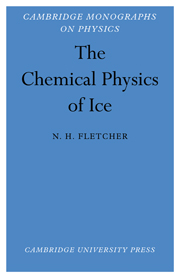Book contents
- Frontmatter
- Contents
- Preface
- Note on Units
- CHAPTER 1 The water molecule
- CHAPTER 2 Structure and energy of ordinary ice
- CHAPTER 3 Other forms of ice
- CHAPTER 4 Liquid water and freezing
- CHAPTER 5 Crystal growth
- CHAPTER 6 Thermal properties and lattice dynamics
- CHAPTER 7 Point defects
- CHAPTER 8 Mechanical properties
- CHAPTER 9 Electrical properties
- References
- Subject Index
CHAPTER 4 - Liquid water and freezing
Published online by Cambridge University Press: 21 May 2010
- Frontmatter
- Contents
- Preface
- Note on Units
- CHAPTER 1 The water molecule
- CHAPTER 2 Structure and energy of ordinary ice
- CHAPTER 3 Other forms of ice
- CHAPTER 4 Liquid water and freezing
- CHAPTER 5 Crystal growth
- CHAPTER 6 Thermal properties and lattice dynamics
- CHAPTER 7 Point defects
- CHAPTER 8 Mechanical properties
- CHAPTER 9 Electrical properties
- References
- Subject Index
Summary
Our understanding of the structure and properties of liquids is in a much less well developed state than is the theory of solids and, for that reason if no other, it is difficult to give a concise view of the subject. Simple liquids like argon or sodium, which behave to a first approximation like an assembly of hard spherical atoms, can be treated reasonably satisfactorily by current methods but the non–spherical nature of the water molecule leads to molecular association in the liquid state which complicates the problem immensely.
In this book, which is primarily about ice, we shall be concerned with only a few aspects of the structure and behaviour of liquid water; a comprehensive discussion of water and aqueous solutions would occupy several volumes. In particular we shall discuss current views on the structure of water at temperatures not too far removed from the normal freezing point and then go on to consider in some detail the phase transition involved in freezing. The actual kinetics of crystal growth will be reserved for discussion in chapter 5. Among reviews of the liquid state which provide useful background are those of Green (i960), Furukawa (1962), Barker (1963), Kavanau (1964) and Pryde (1966).
Experimental information on water structure
In the case of a crystalline solid it is possible to determine, by diffraction methods, the equilibrium positions and vibrational amplitudes of all the atoms involved and this information specifies the structure of the crystal.
- Type
- Chapter
- Information
- The Chemical Physics of Ice , pp. 73 - 103Publisher: Cambridge University PressPrint publication year: 1970
- 12
- Cited by



